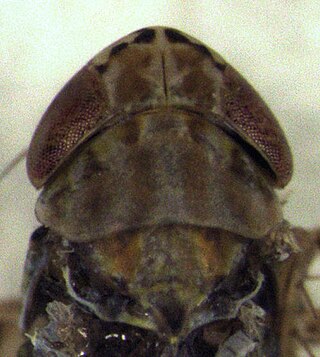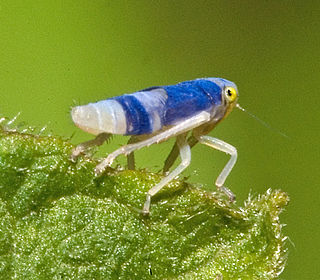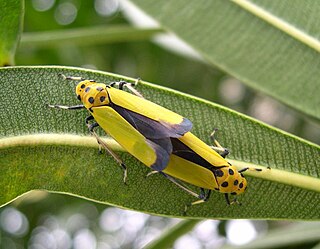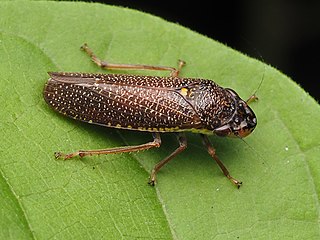
Hemiptera is an order of insects, commonly called true bugs, comprising over 80,000 species within groups such as the cicadas, aphids, planthoppers, leafhoppers, assassin bugs, bed bugs, and shield bugs. They range in size from 1 mm (0.04 in) to around 15 cm (6 in), and share a common arrangement of piercing-sucking mouthparts. The name "true bugs" is often limited to the suborder Heteroptera.

Dicistroviridae is a family of viruses in the order Picornavirales. Invertebrates, including aphids, leafhoppers, flies, bees, ants, and silkworms, serve as natural hosts. There are 15 species in this family, assigned to three genera. Diseases associated with this family include: DCV: increased reproductive potential. extremely pathogenic when injected with high associated mortality. CrPV: paralysis and death.

The glassy-winged sharpshooter is a large leafhopper, similar to other species of sharpshooter.

A leafhopper is the common name for any species from the family Cicadellidae. These minute insects, colloquially known as hoppers, are plant feeders that suck plant sap from grass, shrubs, or trees. Their hind legs are modified for jumping, and are covered with hairs that facilitate the spreading of a secretion over their bodies that acts as a water repellent and carrier of pheromones. They undergo a partial metamorphosis, and have various host associations, varying from very generalized to very specific. Some species have a cosmopolitan distribution, or occur throughout the temperate and tropical regions. Some are pests or vectors of plant viruses and phytoplasmas. The family is distributed all over the world, and constitutes the second-largest hemipteran family, with at least 20,000 described species.

The Auchenorrhyncha suborder of the Hemiptera contains most of the familiar members of what was called the "Homoptera" – groups such as cicadas, leafhoppers, treehoppers, planthoppers, and spittlebugs. The aphids and scale insects are the other well-known "Homoptera", and they are in the suborder Sternorrhyncha.

Brochosomes are intricately structured microscopic granules secreted by leafhoppers and typically found on their body surface and, more rarely, eggs. Brochosomes were first described in 1952 with the aid of an electron microscope. Brochosomes are hydrophobic and help keep the insect cuticle clean. These particles have also been found in samples of air and can easily contaminate foreign objects, which explains erroneous reports of brochosomes on other insects.

The Mymaridae, commonly known as fairyflies or fairy wasps, are a family of chalcidoid wasps found in temperate and tropical regions throughout the world. The family contains around 100 genera with 1,400 species.

The name sharpshooter is used to refer to any of various genera and species of large leafhoppers in the tribe Proconiini of the family Cicadellidae. As with all cicadellids, they have piercing-sucking mouthparts and closely spaced rows of fine spines on their hind legs. The nymphs feed by inserting their needle-like mouthparts into the xylem of the small stems on the plant where the eggs were deposited; the adults have wings and are highly mobile, and most feed on a variety of different plant species. Both nymphs and adults filter a huge volume of dilute liquid through their digestive system to extract the trace nutrients, and much of the water and carbohydrates are squirted forcibly away from the body in a fine stream of droplets, thus earning them their common name.

Maiestas is a genus of insects in the family Cicadellidae, the vast majority of which were formerly placed in the genus Recilia.

Deltocephalinae is a subfamily of leafhoppers. Deltocephalinae is the largest subfamily in the family Cicadellidae and is divided into 40 tribes, comprising over 925 genera, and over 6,700 described species.

Homalodisca is a genus of sharpshooters in the family Cicadellidae and tribe Proconiini. It contains a significant pest species, the Glassy-winged sharpshooter.

Gonatocerus triguttatus is a species of fairyfly. It is an egg parasitoid of the glassy-winged sharpshooter, Homalodisca vitripennis. It was originally described from Caroni County, Trinidad.

Typhlocybinae is a subfamily of insects in the leafhopper family, Cicadellidae. This is currently the second largest leafhopper subfamily based on the number of described species, but researchers believe there are so many taxa yet undescribed that it is probably the largest subfamily. Approximately 6000 species have been described to science so far.

Cicadellinae is a leafhopper subfamily in the family Cicadellidae.

Empoasca fabae belongs to family Cicadellidae and genus Empoasca within order Hemiptera. They are more commonly referred to as the potato leafhopper. In North America they are a serious agricultural pest. Every year millions of dollars are lost from reduced crop yields and on pest management. Crops that are impacted the most are potatoes, clover, beans, apples and alfalfa.

Deltocephalini is a tribe of leafhoppers in the subfamily Deltocephalinae. Deltocephalini contains 72 genera and more than 600 species.

Coelidiinae is a subfamily of leafhoppers in the family Cicadellidae. There are at least 8 tribes, 108 genera, and over 900 species in Coelidiinae.

Scaphoideini is a tribe of leafhoppers. There are 64 genera and over 600 described species in Scaphoideini.

Paraulacizes irrorata, the speckled sharpshooter, is a species of sharpshooter in the family Cicadellidae.

Chandrashekaraswami Adiveyya Viraktamath is an Indian entomologist who specializes in the systematics of leaf-hoppers, Cicadellidae. He served as a professor of entomology at the University of Agricultural Sciences, Bangalore.



















